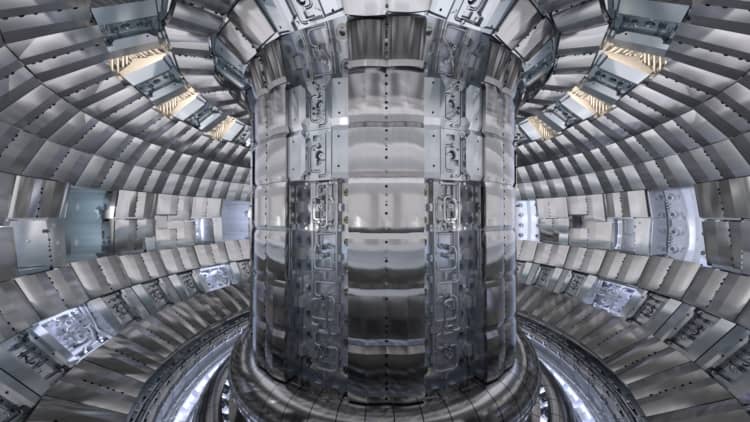[ad_1]
A view of the end of Helion’s seventh generation prototype, the Polaris.
Photo courtesy Helion
Microsoft said Wednesday it has signed a power purchase agreement with nuclear fusion startup Helion Energy to buy electricity from it in 2028.
The deal is a notable vote of confidence for fusion, which is the way the sun makes power and holds promise of being able to generate nearly unlimited clean power, if it can be harnessed and commercialized on earth. For decades, fusion been lauded as the holy grail of clean energy — tantalizing because it’s limitless and clean, but always just out of reach.
related investing news


As responding to climate change has become an increasingly urgent goal for companies and countries around the globe, investors have poured $5 billion into private fusion companies looking to turn that holy grail into electrons flowing through wires.
Microsoft’s agreement to buy electricity from Helion is the first time a fusion company has inked a deal to sell electricity, according to Andrew Holland, the CEO of the Fusion Industry Association.
“This is the first time that I know of that a company has a power purchase agreement signed,” Holland told CNBC. “No one has delivered electricity, and Helion’s goal of 2028 is aggressive, but they have a strong plan for how to get there.”
Helion was founded in 2013 and currently has about 150 employees, with headquarters in Everett, Wash. One of the early and most significant investors in Helion, Sam Altman, is also a founder of OpenAI, the artificial intelligence organization that developed the chat platform ChatGPT, in which Microsoft has invested many billions of dollars. Altman believes the two deals are equally important and correlated components of the future he sees for humanity.
“My vision of the future and why I love these two companies is that if we can drive the cost intelligence and the cost of energy way, way down, the quality of life for all of us will increase incredibly,” Altman told CNBC. “If we can make AI systems more and more powerful for less and less money — same thing we are trying to do with energy at Helion — I view these two projects as spiritually very aligned.”
Samuel H. Altman, the CEO of OpenAI, speaks to media after meeting Japan’s Prime Minister Fumio Kishida at the Prime Minister’s office in Tokyo on April 10, 2023.
The Yomiuri Shimbun | AP
If demand for and use of artificial intelligence continues to increase, then that will increase demand for energy, too.
The potential of fusion is “unbelievably huge,” Altman told CNBC. “If we can get this to work — if we can really deliver on the dream of abundant, cheap, safe, clean energy that will transform society. It’s why I’ve been so passionate about this project for so long.”
In 2021, Altman told CNBC he put $375 million into Helion. As of Tuesday, this is still his largest investment ever, Altman told CNBC. In total, Helion has raised raised $577 million.
Why Helion is announcing a 2028 goal now
As part of the power purchase agreement, Helion is expected to have its fusion generation device online by 2028 and to reach its target power generation of 50 megawatts or more within an agreed-upon one-year ramp up period. When the fusion device is fully up to speed producing 50 megawatts of energy, it will be able to power the equivalent of approximately 40,000 homes in Washington state.
While Helion’s deal with Microsoft is to get 50 megawatts online, the company eventually aims to produce a gigawatt of electricity, which is one billion watts, or 20 million times the 50 megawatts it is selling to Microsoft.
Microsoft will pay for the megawatt hours of electricity as Helion delivers them to the grid.
“This is a real PPA, so there’s financial penalties if Helion can’t deliver power. So we’ve really put our skin in the game on this too — that we believe we can deliver this power and are committed to it with our own financial incentives,” David Kirtley, CEO at Helion, told CNBC.
Helion’s co-founders. From left to right: Chris Pihl (CTO), David Kirtley (CEO), George Votroubek (Director of Research).
Photo courtesy Helion
Altman advocated for the two companies to work together, he told CNBC, but the deal is the result of work Helion has done independently. “It was not my doing,” he said.
Microsoft and Helion have been working together for years, Kirtley told CNBC. “The first visit we had from the Microsoft team was probably three of our prototypes ago, so many years ago. And then we’ve been working very closely with their data center technology team here in Redmond,” Kirtley said.
After all, Microsoft needs power and has aggressive climate goals. Microsoft has a goal to have 100% of its electricity consumption, 100% of the time, matched by zero-carbon energy purchases by 2030. Carbon-free energy includes hydro, nuclear and renewables for Microsoft, a Microsoft spokesperson told CNBC.
“We are optimistic that fusion energy can be an important technology to help the world transition to clean energy,” Brad Smith, president at Microsoft, said in a written statement. “Helion’s announcement supports our own long term clean energy goals and will advance the market to establish a new, efficient method for bringing more clean energy to the grid, faster.”
An electrical engineer preparing for a test at Helion.
Photo courtesy Helion
For Helion to be able to deliver electricity generated by fusion to customers requires years of advance planning on the transmission and regulatory fronts.
In that way, announcing a contract now to sell electricity in 2028 gives Helion time to plan and to pick a location in Washington State to put this new fusion device.
“One reason we’re doing the announcement today is that so we can be working with the communities involved, we can be working with regulators, and the power utility on citing this right now,” Kirtley told CNBC. “Even five years is a short amount of time to be hooked up to the grid. And we want to make sure that we can do that.”
Indeed, the transmission system in the United States, meaning the series of wires that carry electricity from where it is generated to where it is used, is largely tapped out. Getting new power generation connected to the grid can take years. Helion is working with Constellation to secure its transmission needs.
‘We’re not here to build systems in a lab’
The best-known pathway to commercializing fusion is with a donut-shaped device called a tokamak. The international fusion project under construction in Southern France called ITER is building a tokamak, and Commonwealth Fusion Systems, a fusion start-up spun out of MIT which has raised more than $2 billion in funding, is using tokamak technology. For comparison, CFS plans to have its first power plant on the grid and selling electricity in the early 2030s.
Helion is not building a tokamak. It is building a long narrow device called a Field Reversed Configuration.
An infographic showing how Helion’s fusion technology works.
Infographic from Helion
Broadly speaking, Helion’s approach involves shooting plasma (the fourth state of matter after solid, liquid and gas) from both ends of the device at a velocity greater than one million miles per hour. The two streams smash into each other, creating a superhot dense plasma, where fusion occurs.
Helion is currently building its seventh-generation fusion machine, named Polaris, which it aims to produce electricity with by next year, Kirtley told CNBC.
“We’re not here to build systems in a lab. We’re here to sell electricity. This is always been the dream,” Altman told CNBC.
So far, Helion has been able to generate energy with its fusion prototypes, but it has not yet built a device that creates more electricity than it uses to run the fusion device. So the firm has a lot of work ahead.
To that, Altman says: “There were a lot of people that were doubting A.I. six months ago, too.”
“Either the technology here is going to work or not. There’s a lot of huge challenges still to figure out — how are we going to get the cost super-low, how are we going to manufacture at scale — but on the ability to actually do the physics, we feel very confident,” Altman told CNBC. “And I think it’s fine for people to doubt it. But also the way that you eventually reduced that doubt is to show to show people it actually works in the commercial setting, like delivering on this deal.”
Helion has been making progress on some key hurdles.
For example, the company has started making its own capacitors, which are sort of like super-efficient batteries and one of Helion’s very significant capital costs.
It has also started to make the very rare fuel it uses, helium three, which is a very rare type of helium with one extra neutron. It used used to get helium-three from the U.S. government strategic reserves.
Next up, Helion has to demonstrate that its devices can work reliably for long periods of time, and Kirtley has a team working on durability of the components used in the device.
If Helion can be successful, it’s going to be a landmark for the entire fusion industry.
“This really signals that a fusion era is coming. And we’re all very excited about it,” Kirtley told CNBC.

[ad_2]

